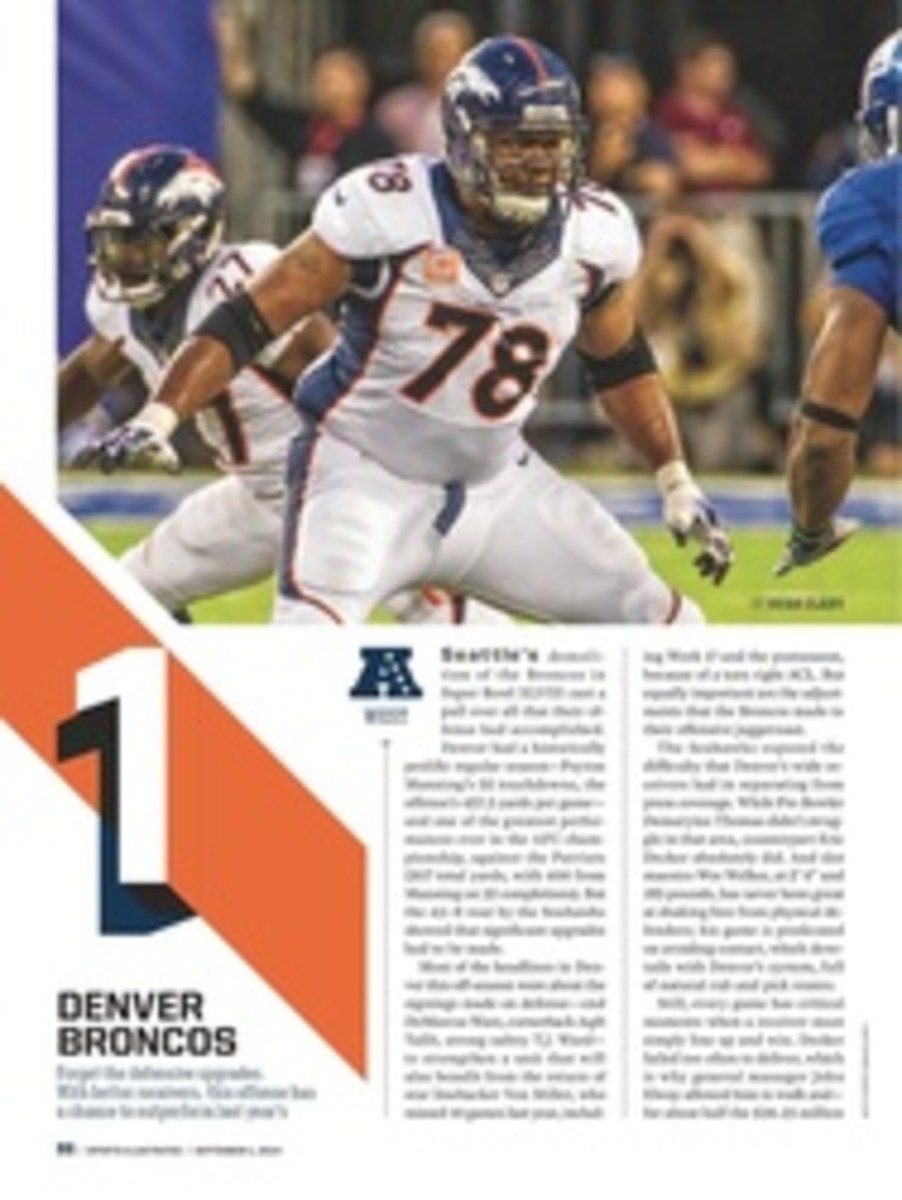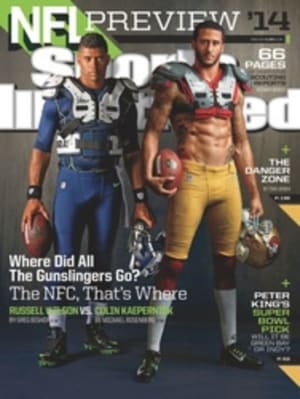
1 SEATTLE SEAHAWKS
Before the Seahawks, the last team to win a Super Bowl through such dominant defense was the 2002 Buccaneers. Since that time there have also been few champions better positioned to defend their title. Seattle is young, and the natural maturation of quarterback Russell Wilson in his third season plus the infusion of playmaking from a now-healthy Percy Harvin put their average offense on a path to improvement. That said, another title will depend on the overwhelming defense.
Every Seahawks defender who was lost this off-season was more than adequately replaced from within. More important, two key cogs were locked up for the long-term: cornerback Richard Sherman (four years, $56 million, $40 million of it guaranteed) and free safety Earl Thomas (four years, $40 million, $27.7 million guaranteed). The loquacious Sherman is the guy everyone knows, but most coaches will tell you that Thomas is what makes this defense go.
Free safeties are often overlooked by fans and analysts, and understandably so: They don't always show up in the television picture and are rarely near the ball. But a great free safety influences games in profound ways, and after Ed Reed, Thomas is the best this generation has seen. A first-round pick in 2010, he has learned to translate his sensational speed into outstanding range with his understanding of route concepts and angles. Also, he explodes in his redirect movement, which helps in disguising coverage. Quarterbacks are taught to read the free safety before anything else. Fearing Thomas's disguises, they're inclined to keep eyes on him a beat longer, wasting precious time and aiding Seattle's four-man pass rush.
This is a subtle factor that makes an entire defense better. Thomas's range means the Seahawks can almost always play single-high coverage, so they don't need to keep another safety back deep. That gives them an all-important eighth defender in the box: Kam Chancellor, who has blossomed into perhaps the finest strong safety in the game. Chancellor is devastatingly physical, fundamentally sound and adroit in coverage, both in man-to-man on tight ends and as a roving zone defender underneath.
That roving coverage is a staple in Seattle's ballyhooed hybrid zone and press-man scheme. The zone element is inside, where the areas of responsibility for Chancellor and Seattle's three speedy linebackers are smaller than is typical. That's because two suffocating press-man corners—Sherman and now Byron Maxwell, replacing Brandon Browner, who signed with New England this off-season—compress the field from the perimeter. They can be aggressive because of the security Thomas provides behind them. Without an All-Pro centerfielder, Sherman would have a much tougher time playing like an All-Pro corner.
Thomas, who is also a bone-rattling run defender, is the most important of this defense's pieces, but he's far from the sole reason for Seattle's success. This unit is extremely well-coached. You see it not only in the safeties' and linebackers' feel for working together in zone coverage but also in the success of the corners. Sherman was a fifth-round pick. Maxwell was a sixth-rounder. So was Jeremy Lane, who will be taking over slot duties from the departed Walter Thurmond, who was a fourth-rounder. Departed Pro Bowl corner Browner wasn't even drafted.
How do the Seahawks keep hitting home runs with their cornerbacks? It can't all be John Schneider's eye for talent, even if the 43-year-old is one of the best GMs in the league. It has to be the way these guys are coached. Pete Carroll, defensive coordinator Dan Quinn and secondary coach Kris Richard are very good at teaching their corners the specifics of press-man and off-man zone techniques. A telltale sign: Every Seahawks corner plays with the same mechanics. Part of those mechanics includes grabbing and holding because these coaches have figured out that human nature inhibits referees from flagging the same infraction over and over—regardless of the league's emphasis this year on calling passing fouls.
The Seahawks can play the same man-zone scheme down after down, which allows players to master the nuances. It also means more blitz possibilities, though with a potent four-man rush, Carroll and Quinn do not exercise these aside from some select third-down packages.
Another Super Bowl run is all the more plausible because scheme and instruction and the application of fundamentals are things that can carry over from year to year—especially when there's a dominant free safety linking the defense together.
2014 SCHEDULE
2013 Record: 13--3
WEEK 1
GB THUR [HOME]
SD [AWAY]
DEN [HOME]
BYE
WAS MON [AWAY]
DAL [HOME]
STL [AWAY]
CAR [AWAY]
OAK [HOME]
NYG [HOME]
KC [AWAY]
ARI [HOME]
SF THUR [AWAY]
PHI [AWAY]
SF [HOME]
ARI [AWAY]
STL [HOME]
WEEK 17
FOCUS ON
The front seven
Seattle's defensive front seven undoubtedly benefits from playing in front of the best secondary in football. But even if it were playing in front of the defensive backfield of the Arena Football League's Spokane Shock, this group would be dominant. The line is rich with pass rushers: Cliff Avril and Bruce Irvin outside, and Michael Bennett, with his plethora of gap-shooting maneuvers, inside. Assuming defensive tackle Tony McDaniel can adequately replace departed weakside end Red Bryant, this group will remain difficult to run against. Bennett is terrific at shedding blocks as a first- and second-down defensive end, and defensive tackle Brandon Mebane plays with a near-perfect combination of leverage and quickness. At linebacker, Bobby Wagner runs like a deer and astutely diagnoses plays (both run and pass) from the middle. Outside, K.J. Wright, Malcolm Smith and Irvin bring tremendous speed, and complete a magnificent seven.
THE CASE FOR
Receiver Percy Harvin
A thundering defense allows the Seahawks to win with a ball-control offense, which is what the still-developing Russell Wilson and workhorse running back Marshawn Lynch have provided. But this year Wilson and Lynch could be used in new dimensions now that Harvin is healthy. Harvin, whom the Seahawks acquired from Minnesota last off-season and signed to a six-year deal with $25.5 million guaranteed, would have been this offense's most dynamic weapon last year if not for hip problems that kept him out for all but 10 quarters (counting the postseason). While he gives Seattle a downfield target, Pete Carroll and GM John Schneider paid so much for Harvin because he could bring a horizontal element to the ground and screen games. Imagine Wilson running an already potent read-option with Lynch in the backfield and then having one of the most dangerous speedsters in the league sweeping in from the outside, adding a third ballhandling threat. That's a nightmare for a defense. Harvin gives Seattle greater big-play potential.
Open the Google app and say, "Ok Google, what is the name of the Seattle Seahawks' mascot?"
PHOTO
JOSHUA WEISBERG/ICON SMI
FS EARL THOMAS
PHOTO
JOHN W. MCDONOUGH/SPORTS ILLUSTRATED
TWENTY PHOTOS

